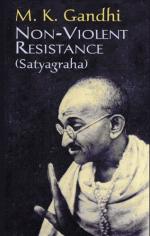|
This section contains 860 words (approx. 3 pages at 400 words per page) |

|
Perspective
Satyagraha has an editor, Jivanji Dahyabhai Desai, who compiles Gandhi's writings and writes a brief preface. However, his main goal is to faithfully reproduce Gandhi's writings and thoughts and get out of the way, as he makes clear in his introduction. Thus, the primary perspective is that of Gandhi (1869 - 1948). Gandhi was the pre-eminent leader of the Indian people, playing a decisive role in the spiritual development of his people and freeing India from British rule.
Gandhi's primary philosophy is the same as the title of the book: Satyagraha. Satyagraha is the social and spiritual philosophy of "holding firmly to truth." It requires a complete abdication of all violent methods of social change and instead employs civil disobedience. Gandhi argues that the soul must be pure and unselfish in order for a person to become a true Satyagrahi and so Gandhi prescribes spiritual disciplines and ascetic practices in...
|
This section contains 860 words (approx. 3 pages at 400 words per page) |

|




